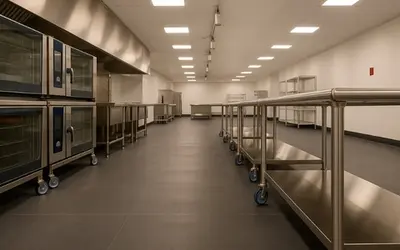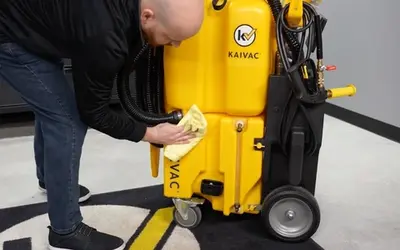The Best Way to Clean a School Cafeteria

A clean school cafeteria is vital for student health. Often serving two meals a day, with lunch a rapid-fire marathon of hundreds of students cycling in and out, school cafeterias can be as busy as any restaurant. Yet food service, and food safety, are not typically an area of expertise among school administrators.
This can lead to some embarrassing problems, like this rodent infestation that temporarily closed Ben Davis High School in Indianapolis. Or this case of gastrointestinal illness causing Las Vegas elementary students to “projectile vomit.” As extreme as these cases are, they serve as a wakeup call to make clean school cafeterias a priority.
Don’t wait for bad news to affect your school’s reputation. Here’s how to clean school cafeterias quickly and effectively.
Clean School Kitchens
All commercial kitchens face unique cleaning challenges and school kitchens are no exception. These spaces are always busy, often greasy, and provide great environments for dangerous bacteria that can lead to foodborne illnesses to grow and thrive.
Good protocols for clean school kitchens help minimize that risk. Reinforce proper cleaning and sanitizing methods for countertops, equipment, and appliances. And don’t forget the floors.
Kitchen floors can be very difficult to maintain, particularly with a mop and bucket. These tools are much better at spreading soil, grease, or pathogens than actually removing them. They can also leave floors tacky with buildup.
The UniVac® by Kaivac makes cleaning school kitchens faster and easier. This technology cleans the grime out of grout, removes fallen food from under equipment, and even gets into tight corners. Its powerful wet vacuum completely removes dirt, grease, and germs from the environment, leaving floors clean, dry, and ready to walk on.
Clean Cafeteria Floors
Cafeteria floors take a beating. Constant foot traffic, rolling carts, and plenty of spills, drips, and messes make cleaning cafeteria floors a challenge. Prioritizing jobs and upgrading tools can help.
Cleaning the entire floor in between lunch periods is not possible or practical. But all spills must be removed immediately to avoid costly slip and fall events. Choosing the right tool, like the AutoVac Stretch™ from Kaivac, makes this task easy. The machine quickly sucks up liquid messes, leaving floors clean, dry, and safe.
Once all the lunch periods are finished, workers can then turn their attention to fully cleaning the cafeteria floor. The AutoVac Stretch is a great choice for this task as well. Faster than a mop and less expensive than an autoscrubber, this technology can clean more than 25,000 square feet an hour. It requires less water and chemicals, and leaves floors 25% shinier than other methods.
Clean Cafeteria Tables
Cleaning cafeteria tables in between lunch periods is important for the health and safety of students. It is also something that parents pay attention to, as shown by this article about protests of a new school policy to only spray the tables with water in between lunch periods.
The parents make a compelling point. “You have multiple students eating at a table or a certain surface over a course of a two- to three-hour period of time and one student might have a stomach virus,” says parent Michelle Brock. “They are running a fever, and then they touch that surface and then a child following them eats on that same surface without it being sanitized or disinfected. It just seems to me that for the safety of our students that it makes sense they would clean the tables with something other than just water.”
The school, however, is just following manufacturer directions. Their cleaning product must dry completely before students use the table. But the school’s busy lunch schedule doesn’t allow for drying time.
An advanced tool, like the KaiFly™ Flat Surface Cleaning System from Kaivac, could satisfy both sides. The KaiFly simplifies cleaning cafeteria tables while delivering consistent results from start to finish. Workers simply:
- Spray surfaces with an all-purpose cleaning solution
- Squeegee the surface
- Catch the soiled solution with a microfiber pad
This method cleans at least six times better than towels or wipes, reduces cross contamination risks, and is fast and easy to use.
School cafeteria cleaning doesn’t have to be hard. Click here for more time and money saving ideas.
Related Posts

Floor Cleanliness and Food Safety Scores
Poorly maintained floors are unsafe and unsanitary. They hold standing water, harbor pests, and cause slip, trip, and fall accidents. Here’s how to improve floor care and your food safety scores.
Read more
Preventive Maintenance for Your No-Touch Cleaning® System
Your Kaivac No-Touch Cleaning system makes restroom maintenance fast and easy. Keeping your No-Touch Cleaning system in good working order is also fast and easy. Kaivac makes performing preventative maintenance and troubleshooting potential issues simple. No special equipment or technical expertise required.
Read more
Beyond the Restroom: Kaivac for Fast, Easy, and Complete Kitchen Floor Care
You already know and trust Kaivac for restroom care. Our No-Touch Cleaning® systems make the unpleasant task of servicing restrooms fast, easy and complete. But did you know Kaivac has cleaning machines for every kind of floor?
Read more